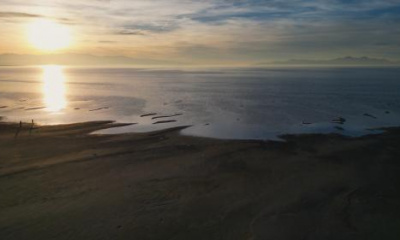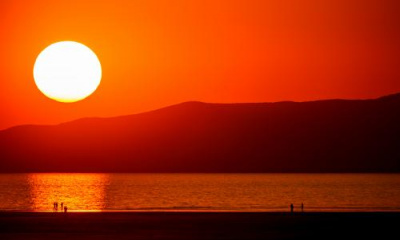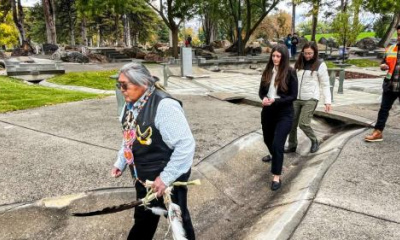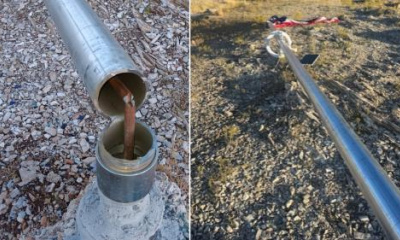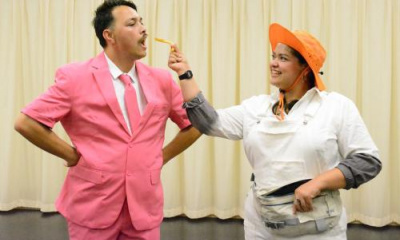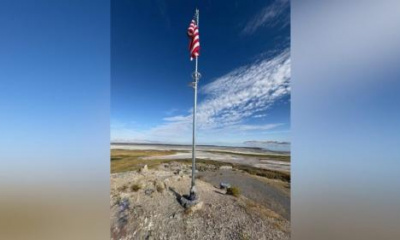ANTELOPE ISLAND STATE PARK — The offerings of water were carried lovingly to the Great Salt Lake's shore in a mismatched array of bottles and jars.
Although they were minuscule, even collectively, next to the lake's expansive waves, children and adults took turns pouring the jars and bottles into the lake Saturday morning as part of an offering ceremony on Antelope Island.
Participants knew their offerings wouldn't change the lake's water levels or slow the impending ecological disaster awaiting Utahns if the lake disappeared. Instead, the offerings represented an outward expression of a love and stewardship of the lake.
"We won't make much of a difference by pouring a few jars of water into this lake," environmental advocate Emily Ostler said. "What is important is the relationship they represent. Relationship is what will save this lake. We act on behalf of what we are brave enough to love."
For Ostler and many others at the ceremony, their relationship with the Great Salt Lake is personal, sacred and, perhaps most importantly, something worth fighting for. Writer and poet milo, who goes by only a first name, has intentionally worked to cultivate that relationship since moving from Colorado to the Salt Lake Valley six years ago.
"My relationship to the lake is ever growing and feels very loving and like this feeling of 'you've got my back,' like this huge, inconceivably ancient being that lives right next door to where I live," milo said. "I'm going through a bunch of stuff ... and to be able to take my sorrows to an island in the middle of an inland sea is precious."
Shoshone leader and historian Darren Parry said that relation with the lake is a familial one. As a child, Parry's grandmother first explained his kinship to the lake, shorebirds and rocks during trips to Antelope Island to gather edible and medicinal plants. Parry said Indigenous wisdom and tribal representation must be included in the decision-making process if the Great Salt Lake is to be saved.
"What if they had been given a seat at the table 100 years ago? Would we be in the situation that we're in with almost every one of our waterways and our environment if we had injected Indigenous values into the system 100 years ago? I think you know the answer," he said. "And (Indigenous voices) are still not included. When you assume that scientific knowledge is superior to Indigenous wisdom, you make collaboration impossible. That is what I think it's going to take to solve the issue, collaboration and all of us coming together."
The value of Indigenous teachings, both from communities native to Utah and beyond, was a recurring theme throughout the ceremony.
"As Indigenous people, we know that we are the protectors of this land. We know that if we take care of this land, it's going to take care of us. So it is up to us to take care of this land," Paiute Indian Tribe of Utah Chairwoman Corrina Bow said, adding that her people were known as the water people. "I hope that you are willing to sacrifice to improve this problem that we have here because if we don't try to reach out and do something about it, it's not going to get any better."
Indigenous activist and dancer Carl Moore stressed that everyone is indigenous to somewhere and that reconnecting with those roots puts environmental issues like the Great Salt Lake's demise into perspective.
"A problem that we've seen with all of our natural resources or nature is that with the coming of this colonial ideology and consumerism and capitalism, it's about taking without asking. ... What do you do when Mother Earth is attacked? You stand up and fight back," Moore said. "At all of our indigenous roots, there's a connection to land. There's a connection to water and there's a connection to community. Unfortunately, in this culture that we have today, this American culture or Westernized culture, that has been lost."
Teri Harman didn't have to dig far into her Norse roots to find that connection to water. She told those at the ceremony the story of the Norns, a triad of deities who tend the well of fate, which is used to sustain the tree of life. While watching the Norns, the god Odin is said to have traded his own eye in exchange for a drink from that well.
"He realized that water was the source of all wisdom and all strength and it could teach him everything," Harman said. "Water offers the wisdom of the world. Are we listening? Are we willing to do what it takes in the quest to save our water? Our interwoven watershed here in Utah is our well of fate that tends our tree of life. Every person living in Utah is sustained by this water whether they recognize it or not."


